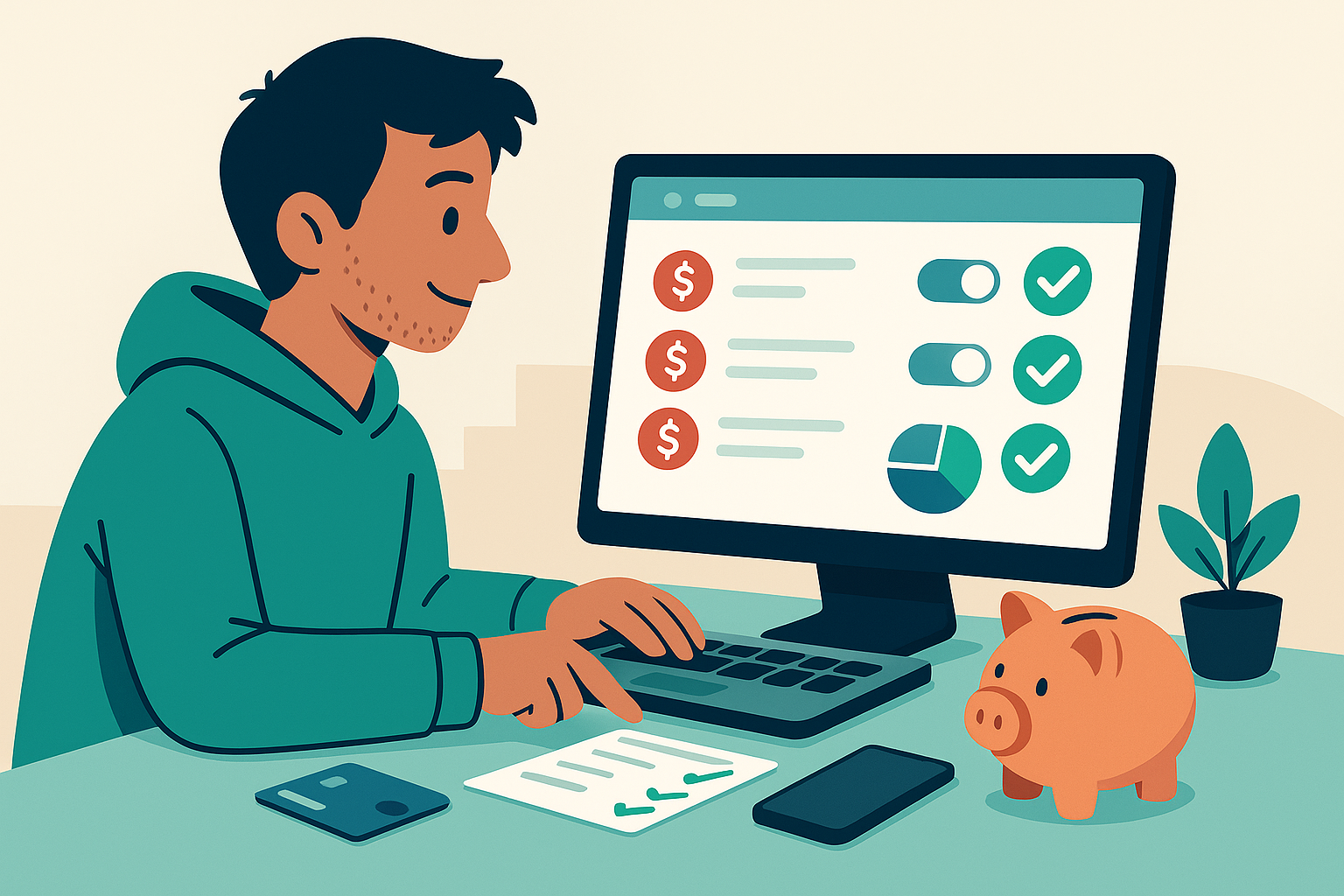Bank Fees Audit: how to dodge ATM, overdraft, and monthly charges (and the fine print to watch)
One-hour playbook to find and stop bank fees: ATM, overdraft, monthly maintenance, and the sneaky fine print—plus scripts to request refunds.

TL;DR: Pull the last 12 months of statements, search for fee keywords, total them up, then (1) switch settings to avoid them, (2) ask for refunds, and (3) choose accounts whose rules you actually meet.
A quick story from Fin
I used to treat bank fees like weather—annoying, but unavoidable. Then I totaled a year of charges and realized I’d paid enough to buy a decent set of pans (and you know I love cooking 😅). One hour later—three settings changed, a phone call made—and the leak stopped. This post is that one-hour playbook.
The 1-hour Bank Fees Audit
What you need: your bank app + 12 months of e-statements (PDF or CSV).
1) Search & tally
Use your bank’s search or a PDF search for terms like:
- monthly maintenance, service charge, account fee
- overdraft, OD, NSF, returned item, extended overdraft
- ATM fee, out-of-network, foreign ATM
- foreign transaction, international transaction, FX
- paper statement, stop payment, wire, early closure, excess withdrawal
Add them up. Knowing the number gives you leverage when you call.
2) Fix settings that trigger fees
- Low-balance alerts: turn on push/SMS.
- Overdraft settings: consider opt-out of debit/ATM overdraft so transactions decline instead of feeing you. If you keep coverage, link a savings account and check the transfer fee—sometimes it’s cheaper.
- Direct deposit / minimum balance: if your account waives the monthly fee with a certain deposit or balance, set up a paycheck split or move buffers so you actually qualify.
- ATM network: bookmark your bank’s ATM map; aim for in-network only. If you’re paying a surcharge often, try cash-back at checkout for small cash needs.
- Paper statements: switch to e-statements.
- International travel: turn on travel notifications (if offered) and use cards/accounts with no foreign transaction fee when you travel.
3) Ask for refunds (script)
Call or chat with support right after a fee posts.
“Hi! I’m reviewing my account and I noticed a $___ [type] fee on [date]. I’ve been a customer for [X years] and I’ve adjusted my settings so this won’t happen again. Could you please courtesy-refund this fee? I’d really appreciate it.”
If they say no, try:
- “Is there a way to change my account type so I meet the monthly waiver?”
- “Could you review my last 12 months—if this isn’t frequent, can you make an exception?”
You can usually get 1–2 courtesy refunds a year per account if you’ve been solid.
The big three fee buckets (and how to dodge them)
1) ATM fees (double whammy risk)
You can get hit twice:
- Your bank’s out-of-network fee, and
- The ATM operator’s surcharge (shown on-screen).
Dodge plan:
- Use in-network ATMs only—your app can filter for them.
- Withdraw less often, slightly larger amounts to reduce hits.
- Get cash back at grocery/drugstore when you buy something.
- Traveling? Some banks participate in shared networks (e.g., large surcharge-free networks). Check your app before you go.
2) Overdraft & NSF fees
Two common setups:
- Debit/ATM overdraft coverage: bank approves the purchase and charges a fee.
- Overdraft “protection” from savings/credit line: automatic transfer with a smaller transfer fee.
Dodge plan:
- Consider opting out so debit/ATM transactions decline if funds are short.
- If you keep coverage, link savings and confirm the transfer fee is lower than an overdraft fee.
- Turn on low-balance alerts and move bill due dates closer to payday.
- Some banks cap daily overdraft fees or give grace windows—know your bank’s rules.
3) Monthly maintenance fees
Usually waived if you meet one or more:
- Direct deposit of $X/month
- Minimum daily or average balance
- X debit transactions or linked products
Dodge plan:
- Pick the waiver you can actually meet, every month.
- If none fit your life, switch to an account with no monthly fee / no minimum (credit unions and some online accounts offer this).
- Students and young adult accounts often have automatic waivers—ask.
Fine print to watch (sneaky but legal)
- Authorized positive/settled negative: a debit card transaction is approved when your balance looks OK, but posts later after other items, ending negative—fee triggers. Alerts + opt-out help.
- Excess savings withdrawals: some banks still charge if you move money out of savings too often in a month.
- Early account closure fee: opening a promo account & closing quickly can trigger this.
- Dormancy/inactivity fees: keep one tiny recurring transfer to show activity.
- Stop payment/wire fees: high and non-refundable—confirm amounts before you request.
If you bank internationally (or shop online abroad)
- Foreign transaction fees (often ~1–3%) add up. If you travel, consider an account/card that charges 0% (policies vary).
- At a foreign terminal, when asked, choose local currency to avoid dynamic currency conversion markups.
- Use your bank’s international ATM partners to reduce cash fees when abroad.
A simple “stay fee-free” checklist
- Low-balance + large-purchase alerts ON
- Overdraft opt-out (or cheaper linked transfer)
- E-statements ON
- In-network ATM map bookmarked
- Direct deposit or minimum balance waiver in place
- One tiny monthly transfer from checking → savings (keeps accounts active)
- Calendar reminder: Quarterly 15-minute fee check
Fin’s take
Most fees aren’t moral failings—they’re rules mismatches. Match your account to your life, automate a couple guardrails, and you’ll keep your money doing better things (hello, emergency fund ramen celebration 🍜).